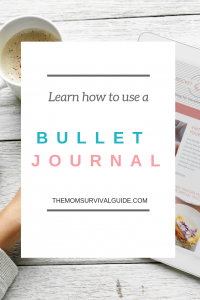Bullet Journaling – Guest Post!
I am so excited today to have a guest post by Jennifer from ParentSmarterNotHarder.com.
And guess what she will be writing about! Bullet Journaling!
Bullet journaling is something that I have been wanting to start doing but haven’t had the time to look into it! So when Jennifer offered to do this post, I was thrilled!

There are sponsored links on this page from which I may get a commission at no added cost to you. For more information, please read my Privacy Statement.
Here is a little about the Author:
After a successful career in software engineering, Jennifer started working part-time as a project manager. She was overwhelmed with all of these new life changes and felt like she was drowning in life. After trying so many different systems that didn’t work, Jennifer looked into why they didn’t work and came up with a system just for her. Today, she shares what she’s learned with others, using her technical background to help frame these systems in a new light. You can find more of her writing on her blog Parent Smarter, Not Harder. (www.parentsmarternotharder.
So let’s start learning about Bullet Journaling!
What is bullet journaling?
Bullet journaling is a system of planning that uses a notebook with certain notations to organize pretty much everything.
In the easiest form, bullet journaling is a set of lists. All you really need for it is a notebook. Everything else is what you do with that journal.
This is an analog system that requires you to write everything down. Rather than writing down full thoughts thought, you use rapid logging to jot down a bunch of ideas quickly at once. Think of it as a glorified brain dump.
Different ways to organize your tasks
Bullets are used to keep track of it all and organize. Depending on how you note everything, it’s either a task, a note, or an event. Visually it’s easy to keep track of it all.
Tasks are noted with a dot instead of a checkbox. It’s faster to write, it’s cleaner than a box, and it can easily be changed to a different type of task. If you move a task, schedule a task, complete a task, or cancel a task, it’s easy to make a note.
Events are open circles. These are short points that help us keep track of what was done. It gets it out of our brain and onto the paper. You now have a record of your experiences and can figure out where you are spending your time.
Notes have a dash. These are ideas, thoughts, and anything that isn’t a task or event. It’s best to use these for things you don’t want to forget. It’s especially useful for meeting notes, class notes, or book notes.
Because we have these notations, we can use them in any order. The organization doesn’t matter as much because we can visually scan for what we need. It’s more important to get these thoughts down on the paper than anything else.
The basics of a bullet journal
Now that we have the notations down, it’s time to talk about collections.
There are four different types of collections in the official bullet journal methodology.
First is the index. This section in the front of your notebook is a table of contents. For each spread that you make (more on spreads later), you write down the title and the page where you can find it. This makes it easy to find what you are looking for.
The future log is a way to see what’s going on in future months. This lets you see what’s coming up without getting bogged down by the details.
The monthly log is created at the start of each month. It contains a calendar and a task list. The calendar helps you keep track of dates, record past events, and anything else you might need to reference. 
The task list helps you keep track of all the things you need to get done that month. It might contain any tasks you didn’t get done last week, what is coming up and important tasks that you do every month.
Finally, you have your daily log. This is your day-to-day plan. It’s where most of your bullets will go. You put the date at the top and brain dump throughout the day. Then the next day picks up from wherever you left off.
Now that we’ve talked about the main collections, you may also have other collections. These represent specific projects or events, whatever you need based on your own life.
If you are really into fitness, you may have a fitness log. If you have a project at work, you may want to keep all those tasks together. You can always migrate these tasks into your daily log as needed.
And that is the basics of bullet journaling. It’s a lot at first, but once you get going with it, it can completely change the way you plan.
What supplies do you need?
First, you’re going to need a notebook. There are many different factors that come with choosing a notebook.
Most people like bound notebooks. Some like blank pages, others like them lined, and still others either do grids or dot grids. Each has its pros and cons.
The paper quality matters as well. Some have more “bleed through” than others. The bleed is how much ink you can see on the back side of the paper. If you are writing on both sides, it can be difficult to see what you wrote if there’s a lot of bleeding.
Some notebooks come pre-numbered. Because the index depends on page numbers, it’s important that each page has its own number. You can do it yourself, but some people would rather buy a pre-numbered journal.
After you deal with your notebook, you’re probably going to want to think about pens. Bullet journaling uses pens, not pencils. If you make a mistake, you can just cross it out.
Because you’re going to do a lot of writing, you want a comfortable pen that you can easily read. Everyone has their own preferences, but it’s important to test your pen on your notebook for bleed and to make sure that it doesn’t smudge.
There are other supplies some people use. Some use stickers or washi tape to decorate their spreads while others use stamps for the same tasks over and over again. All of these are optional.
Start with a brain dump
To start, set up pages for your index and your future log. I like to sit down with my calendar and plan everything out.
Next, do a brain dump for all your larger projects. I like to do a separate collection for each different type of project or theme.
Once you have a bunch of collections, I go through and add them to my index.
Then I start my monthly spread. I add any events to my calendar and write down my monthly tasks. I migrate over tasks from my collections and see what I want to accomplish for the month.
Each day, I set up a new daily log and go from there. If a project comes up or I feel like I need another brain dump, I start on a fresh page and get it down on paper.
Where to look for inspiration to level up
This simple system is bullet journaling in its intended form. That being said, there are a LOT of people who have taken it to the next level.
Spreads can be anything you want and there are a lot of ideas floating around the Internet.
The best places to look are Pinterest and Instagram. There are a few Facebook groups out there as well that you can join.
The important thing to remember, however, at the end of the day, this journal is for you and it has a practical purpose. If you like to be creative with it, then that’s fantastic! But if you let it overwhelm you and you stop using it, that’s not good either.
So when looking at inspiration, remind yourself that this is for you to get organized. Happy planning!
““““““““““““““““““““““““““`
There you have it! I know a lot of you are keeping up with my Empower Yourself Through Organization Series! Starting a Bullet Journal may be just what you need to get your time managed and reach your organizational goals.
I look forward to the next project we do together!


As a stay at home mom myself, I have found ways to keep myself sane and organized while loving what I do …be home with my kids! After 14 years of being home, I realized other moms may benefit from some of the tips and tricks I have learned over the years. Join me to learn ways to manage your home and life as a stay at home mom so you can make time to enjoy the best part…family. Things I love…feeling motivated, Harry Potter, being outside, and digging deeper into my life and my family’s life in order to make it better. I have a Degree in Biology and am also a freelance writer.


